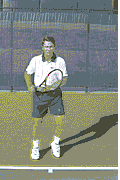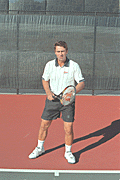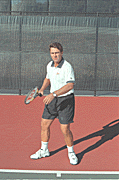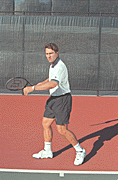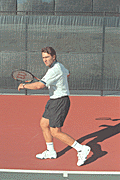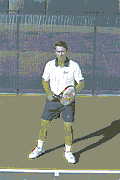|
TennisOne Lessons
The Unit Turn - Your Tennis Foundation
Jim McLennan A favorite question to our juniors in the afternoon classes goes as follows, "OK, so you are in the ready position with the knees bent, racquet held lightly in front of you, intently watching your opponent as they are about to hit. Now, just what exactly is it that you are ready to do?" The answer goes to the heart of the game and tells a lot about your own feel for tennis. Often heard responses include, "Get the racquet back," or "Start moving my feet to the ball," or "Take a quick skipping step to the ball." In some ways each answer might apply for certain situations, but the simplest move, the most efficient response to the situation and the correct answer to the question is, "I am ready to turn." Nothing more, nothing less, just turn. The turn must be as soon as possible. The turn should not disturb your balance or your vision, and it should be quick but equally subtle. This simple turn, aka the "unit turn," rotates the hips and shoulders as one unit, and puts you immediately into either a running or hitting position. Running, because your hips are now facing the direction you will move, and hitting because your shoulders are lined up for an efficient swing.
A few comments about leverage and power. Tennis is a game of optimal power, not maximum power. That is, it's great to crack the ball, but first and foremost you must control the ball. This is what the unit turn gives you and why I've described it as the foundation of your game. Teaching pros often say something like, "You should feel your body swinging the arm and racquet. You should never feel like your arm swings the racquet." In order for your body to swing the arm, you needs both linear and rotational momentum . When I've completed my unit turn, my weight is on my back foot and my hips and shoulders are turned sideways to the net and the on-coming ball. Therefore, I am poised to step and turn back into the hit, momentum going foreward with the feet and then rotational momentum with the hips and shoulders. Controllable leverage, controllable power, effortless tennis. When studying professional examples, Jimmy Connors had as simple a unit turn as any modern player. Efficient, because he made that same turn for all forehands and all backhands. Further, because his style was to play the ball very early, his turn was as quick as any ever seen (Agassi may actually be taking this early preparation to a new level but that is another story). The simple and quick unit turn enables early preparation, ensures a good jump on the ball when you have to move, and adequate body rotation into the shot because of your initial turn to prepare for the ball.
In the photo sequence above I am moving from a ready hop (click here for more on ready hop) into either the forehand or backhand. As you study the pictures note the following elements, which will be your own keys to perfecting this move as you practice it again and again and again.
Forehand Unit Turn
The elements for the backhand unit turn are the same as the forehand (see the animation of the unit turn for backhand above). A Personal Note on the Unit Turn When I met tennis coaching legend Tom Stow (who later became my coach) in 1974 ( see my series on the Tom Stow All-Court Forcing Game ), I was an experienced player with a ranking in men's open singles in Northern California. I played pretty well but Tom had much bigger plans for me, which I soon embraced, but these plans required that I improve my fundamentals. So we began at the beginning, practicing my turn. Tom positioned me on the baseline, and he stood on the service line on my side of the court. I would assume the "waiting position," as he called it, waiting for the ball and waiting to turn and hit. He would gently toss the ball to my forehand and I would swing away, again and again. Then he moved slightly closer to me, and again I would swing and swing. But very subtly, he was tossing the ball quicker and quicker so I had to turn suddenly in order to have time to hit. In retrospect I now realize that his tosses were about one second from his hand to my racquet, which is just about the same time for returning ground strokes from the opponent. So after I am hitting the ball fairly well, Tom would make another throw but not release the ball so as to trick me, but the secret was that Tom would dissect any miscue I might have made in this situation. That is, had I turned and raised my arms he would say, "Now Jim, I only told you to turn, nothing more." Had I flexed my wrist or stiffened my elbow from my original waiting position, again, "Jim, turn and nothing more." Had I turned but leaned over slightly to be out of balance, again, "Jim, please just turn and nothing more." After a few months of this (yes, a few months), my turns had become automatic. I was much smoother, I had much more time to get to the ball, and I had begun to experience the feel of playing effortlessly. Your comments are welcome. Let us know what you think about Jim McLennan's article by emailing us here at TennisONE.
|
||||||||||

